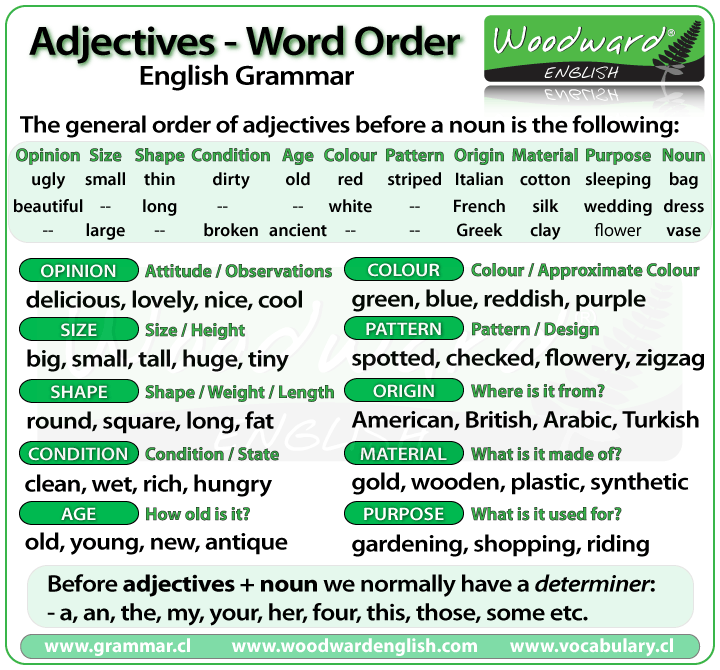An adjective is a word that describes something (a noun) or someone (a person).
Adjectives sometimes appear after the verb To Be
- He is short.
- She is tall.
Adjectives sometimes appear before a noun.
- Red car
- Old hat
BUT… Sometimes you want to use more than one adjective to describe something (or someone).
What happens if a hat is both old AND ugly?
Do we say… an ugly old hat OR an old ugly hat?
An ugly old hat is correct because a certain order for adjectives is expected
(Note, you may hear the other version old ugly hat, though it doesn't sound natural)
So what is the correct order of adjectives when we put them before a noun or the thing they describe?
Here is a chart that shows the main word order for adjectives in English:
THERE IS AN UPDATED VERSION OF THIS CHART HERE: ADJECTIVE WORD ORDER
IMPORTANT: The order of adjectives before a noun IS NOT FIXED.
This chart is only offered as a guide and is the order that is preferred.
You may see or hear slight variations of the order of adjectives in real life though what appears in the chart above is order that is expected the most.
Let's look at each type of adjective in more detail (with examples)…
Types of Adjectives
Before the adjectives you will normally have the Determiner.
Determiner: The determiner tells us if the noun is singular or plural, definite or indefinite
- a, an, the, my, your, four, those, some etc
And then we have the adjectives that refer to…
Opinion: Explains what we think about something. This is usually our opinion, attitude or observations. These adjectives almost always come before all other adjectives.
- beautiful, boring, stupid, delicious, useful, lovely, comfortable
Size: Tells us how big or small something is.
- big, small, tall, huge, tiny
Shape / Weight / Length: Tells about the shape of something or how long or short it is. It can also refer to the weight of someone or something.
- round, square, circular, skinny, fat, heavy, straight, long, short,
Condition: Tells us the general condition or state of something
- broken, cold, hot, wet, hungry, rich, easy, difficult, dirty
Age: Tells us how old someone or something is.
- old, young, new, ancient, antique
Colour: The colour or approximate colour of something.
- green, white, blue, reddish, purple
Pattern: The pattern or design of something.
- striped, spotted, checked, flowery
Origin: Tells us where something is from.
- American, British, Italian, eastern, Australian, Chilean
Material: What is the thing made of or constructed of?
- gold, wooden, silk, paper, synthetic, cotton, woollen
Purpose/Qualifier/Use: What is it for? These adjectives often end in –ing.
- sleeping (bag), gardening (gloves), shopping (bag), wedding (dress)
If you look at the examples above, you can ask… what are the gloves used for? (gardening) What is the bag used for? (shopping)
And after these we adjectives we have the…
Noun: The person or thing that is being described
Examples of the order of adjectives before a noun
Something to have in mind is that it does not sound natural using three or more adjectives in the same sentence and it is very rare to hear four adjectives together before a noun.
- A big fat dog.
- An interesting old Indian rug.
- A striped silk shirt
- Some comfortable black sleeping bags
- Four small round wooden tables
- Those funny little old men








0 Comments